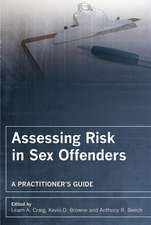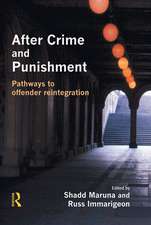What Else Works?: Creative Work with Offenders
Editat de Jo Brayford, Francis B Cowe, John Deeringen Limba Engleză Paperback – feb 2010
The book seeks to dispel the view of probation service users as 'offenders', and socially excluded people as 'problems' to be managed and treated, and instead considers more creative alternatives to reduce both re-offending and social exclusion. These include working separately with women, black and minority ethnic groups, local community-focussed projects, in education and nature and conservation programmes. The reader is encouraged to think about past and current policy, practice, and the relationship between practitioners and offenders or other socially excluded people. Questions are raised as to whether, and how, practice could be different and contributors explore the theme of creative and change-focussed practice or focus on a particular approach to a practice.
This book will appeal to students on criminal justice, criminology and social work courses, professionals operating in these fields as well as the wider audience of professionals and academics who may engage with these ‘service users’ from a range of policy and practice perspectives.
| Toate formatele și edițiile | Preț | Express |
|---|---|---|
| Paperback (1) | 248.79 lei 6-8 săpt. | |
| Taylor & Francis – feb 2010 | 248.79 lei 6-8 săpt. | |
| Hardback (1) | 769.00 lei 6-8 săpt. | |
| Taylor & Francis – feb 2010 | 769.00 lei 6-8 săpt. |
Preț: 248.79 lei
Preț vechi: 297.06 lei
-16% Nou
Puncte Express: 373
Preț estimativ în valută:
47.60€ • 49.84$ • 39.39£
47.60€ • 49.84$ • 39.39£
Carte tipărită la comandă
Livrare economică 05-19 aprilie
Preluare comenzi: 021 569.72.76
Specificații
ISBN-13: 9781843927662
ISBN-10: 1843927667
Pagini: 304
Dimensiuni: 156 x 234 x 20 mm
Greutate: 0.52 kg
Ediția:1
Editura: Taylor & Francis
Colecția Willan
Locul publicării:Oxford, United Kingdom
ISBN-10: 1843927667
Pagini: 304
Dimensiuni: 156 x 234 x 20 mm
Greutate: 0.52 kg
Ediția:1
Editura: Taylor & Francis
Colecția Willan
Locul publicării:Oxford, United Kingdom
Cuprins
Part 1 1. Introduction 2. Creative Work: An Historical Perspective 3. Travelling Hopefully: Desistance Theory and Probation Practice 4. Bringing Sense and Sensitivity to Corrections: from Programmes to 'Fix' Offenders to Services to Support Desistance Part 2 5. Women Offenders: More Troubled than Troublesome? 6. Residential Work with Adult Offenders: Greenhouses or Warehouses? 7. Creative Working with Minority Ethnic Offenders 8. Asset-based Welfare and Youth Justice: Making it Local 9. Dancing through Gaps: a Welsh Approach to Personal Support in Custody for Young People 10. Contemporary Sex Offender Treatment: Incorporating the Circles of Support and Good Lives Model 11. Getting Out: Offenders in Forestry and Conservation Work Settings 12. Putting the OM into NOMS: Problems and Possibilities for Offender Management 13. What Else Works – Back to the Future?
Recenzii
'This edited volume provides a thoughtful antidote to fears of an 'over-reliance on cognitive behaviourism as a theory of intervention and group work as a system of deliver' (p. 3) within work with offenders. The editors are forceful in their assertion that the 'What Works' agenda has 'led to the exclusion of other theories and forms of intervention and the downplaying of the relationship between the supervisor and supervised' (p. 3), although they avoid being dogmatic in their approach.
This volume has a lot to offer for a range of people and I would strongly recommend it to practitioners in any area of criminal justice, academics and, perhaps most wholeheartedly, policy makers interested in implementing more relational, inclusive and reflexive offender-focused practice.' - Jake Phillips, PhD Candidate, Institute of Criminology, University of Cambridge
This volume has a lot to offer for a range of people and I would strongly recommend it to practitioners in any area of criminal justice, academics and, perhaps most wholeheartedly, policy makers interested in implementing more relational, inclusive and reflexive offender-focused practice.' - Jake Phillips, PhD Candidate, Institute of Criminology, University of Cambridge
Descriere
This book taps into the growing awareness amongst practitioners that centralized notions of ‘one size fits all’ approaches to work with offenders in inevitably limited in its effectiveness, and instead seeks to consider more creative alternatives to reduce both re-offending and social exclusion. This book proves interesting reading for students on criminal justice, criminology, and social work courses, as well as professionals working in related fields.










